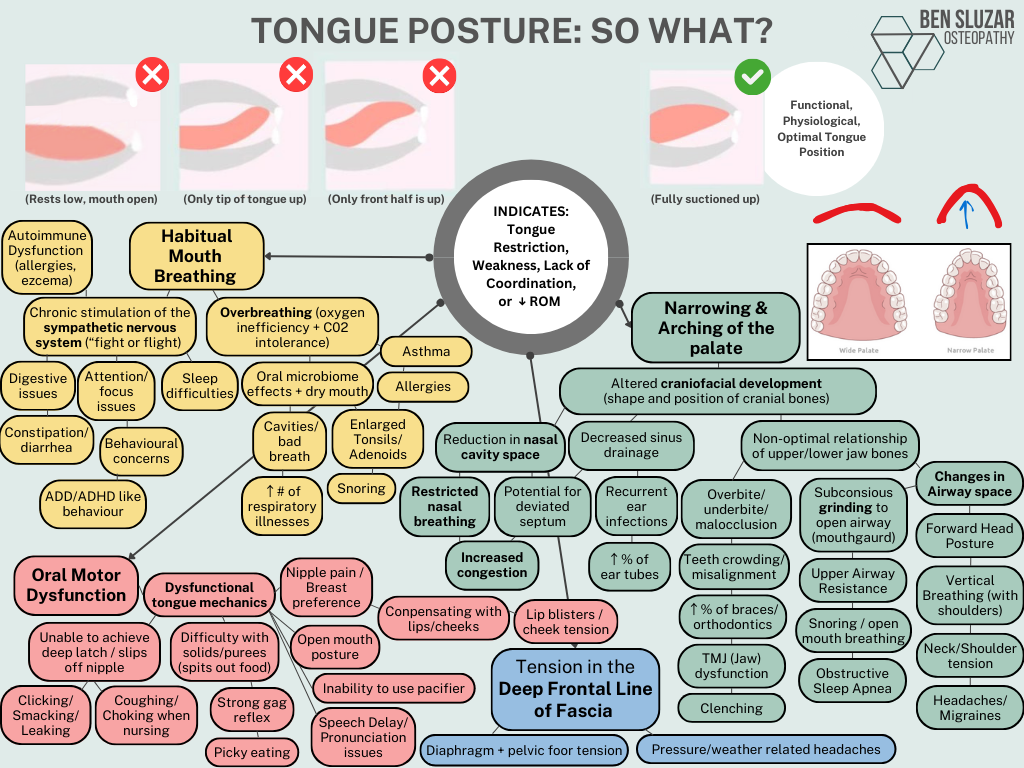NOTE: This is not meant to induce fear or anxiety about what could come from a restricted tongue- but rather to act as an informational tool to help educate on the potential connections that a dysfunctional tongue posture can have on the rest of body. Because of how many different pathways of interconnection there are; the presentation of oral restrictions can be slightly or vastly different from person to person. If any of the above symptoms are present, it is advisable to at the very least, confirm whether oral dysfunction could be part of, or the root cause, of the issue(s).
Where is your tongue as you read this? Is it suctioned up against the roof of the mouth? It could also be:
resting low in the mouth, perhaps with your mouth open?
the tip of the tongue is up behind your two front teeth, but is the back is resting down low?
the front half is up against the roof and behind your teeth, but maybe the back half is still resting low?
These positions represent a dysfunctional tongue posture and indicate the potential need for OMT (orofacial myofunctional therapy), or what I like to refer to as “tongue physio”- exercises that re-train, strengthen & coordinate the tongue for improved oral posture. This can have dramatic impacts on breathing mechanics, jaw pain/tension, neck and shoulder pain/tension, headaches/migraines frequency/intensity, sleep issues (snoring, low energy levels), digestive issues, etc.
If there is a need for OMT, there is also a need for osteopathic assessment and treatment, due to the vast connections that the tongue has on other structural and fascial tissues in the body.
IDEAL RESTING POSTURE OF THE FACE & MOUTH
(AKA ORAL RESTING POSTURE)
* DEEP FRONTAL LINE OF FASCIA *
Image A - The DFL depicted running through a babies body. Image B - A dissected DFL outside of the body.
Deep frontal line (DFL) of fascia: a series of interconnected structures running from the tongue, all the way down the neck, through and intertwined with the diaphragm, the hip flexors, knee, and into the muscles of the lower leg and foot. If parts of this chain are restricted or have limitations, it can have an impact down any length of this chain. This is just one of the reasons we must ensure out tongue is freely able to reach the roof of our mouth comfortably. It also helps to start explaining how restricted tongue movement can have impacts in two major areas-
1) Deep Stabilization System (DSS) is a crucial part of moving through milestones like lifting head in tummy time, lifting legs up and holding them up when on their back, as well as rolling, crawling, pulling to stand, etc. It is kickstarted by the diaphragms movement and initiation of intraabdominal pressure. If this system is inhibited by restriction, a baby can struggle to reach milestones like lifting legs, pushing up in tummy time, rolling, crawling, and sitting independently in a timely manner.
2) Digestive system issues, such as increased gas, spit-ups, fussiness, constipation, explosive/loud poops, straining to poo. These can potentially result from a combination of swallowing air due to latch mechanics, diaphragmatic tension that can then affect the abdominal & pelvic fascia and therefore the function of the esophagus, stomach, liver, or upper or lower intestines.
Infant suck training exercises from an IbCLC
4 PART SERIES ON TONGUE EXERCISES for adults & Older Children
Watch the following 4 videos to get a visualization of where the tongue should sit in our mouths at rest (awake AND asleep!). This is meant to produce some awareness of your tongue position. Performed daily, these exercises help retrain, strengthen, and coordinate the tongue to help it stay on the roof of the mouth, but ultimately they should be performed under the guidance of an orofacial myofunctional provider for more individualized and specific exercises.
If these exercises feel difficult or near impossible, you would likely benefit from both seeing your osteopathic practitioner as well as working with an oromyofunctional therapist or speech language pathologist who specializes in OMT (oromyofunctional therapy).
Feel free to reach out at bsluzar@gmail.com for help finding an appropriate practitioner.
slightly more nuanced version of more exercises
** To diver even deeper into this topic, check out the recommended reading page for some great books! **




